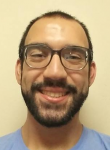Valencia, Dylan

Dylan is in the Biochemistry, Molecular and Structural Biology Graduate Program. He received a B.S. degree in Biochemistry & Molecular Biology from the University of California, Davis. He joind the CMB Training Program in 2019.
Mentor: Dr. Atsushi (Austin) Nakano, Dr. Margot Quinlan
Every cell has a complement of distinct actin-based structures that play specific roles. These structures help cells maintain integrity and polarity, they drive endocytosis and cytokinesis, and in the cases of motile and muscle cells, they are a major component of the contractile machinery. Actin nucleators, proteins that stimulate formation of new filaments, are essential determinants of actin architecture. Understanding the design principles that distinguish nucleators, such as formins, provides insight into how they build distinct structures. Formins in the Formin HOmology Domain (Fhod)-family play important roles in development, immunity, muscle maintenance, and other processes.
Mammals have two Fhod-family formins, Fhod1 and Fhod3. Fhod3 is enriched in muscle cells, including cardiomyocytes, where it is critical for sarcomere development and maintenance. Fhod1 is predominantly expressed in non-muscle cells but is also expressed in muscle cells. In cardiomyocytes, Fhod1 is associated with non-sarcomeric structures, including costameres and intercalated discs, structures important for cellular integrity and mechanotransduction. Therefore, the cardiomyocyte is an ideal cell type in which to study how two closely related formins build distinct structures. Further, both Fhod1 and Fhod3 are implicated in human cardiomyopathies. Polymorphisms in Fhod3 are thought to account for 1-2% of hypertrophic cardiomyopathy cases. In dilated cardiomyopathies, increased expression of Fhod1 and decreased levels of Fhod3 are detected, consistent with the idea that the two formins play distinct roles.
My work is to understand the biochemistry of Fhod1 and Fhod3 both in vitro and in vivo in stem cell-derived cardiomyocytes by testing their necessary activities to build distinct actin-based structures. To do this, I’ll be using bulk assembly assays and total internal reflection fluorescence (TIRF) microscopy, as well as various human cell culture techniques. As a result, this work can help us understand how Fhods function and are associated with cardiomyopathies.


